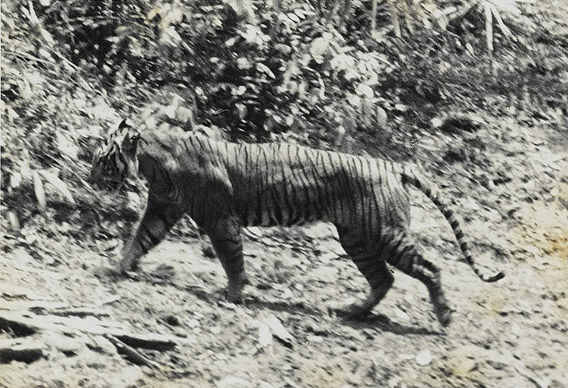
A Javan tiger in 1938 at Ujung Kulon. Photo by: Andries Hoogerwerf.
Although officially declared extinct in 2003, some people believe the Javan tiger (panthera tigris sondaica) is still alive in the island’s Meru Betiri National Park. To prove the big cat has not vanished for good, wildlife officials have installed five camera traps in the park, reports Antara News.
This is not the first time camera traps have been used to attempt to prove the existence of the tiger on Java. Two past camera trap expeditions, both in the 1990s, failed to photograph a single tiger, and the last confirmation of a tiger occurred in 1976. Still, unconfirmed sightings of tigers in the area continue.
“I am optimistic that Javanese tigers still exist at Meru Betiri, although no TNMP officer has seen the animal personally and the trap cameras that we installed several years ago didn’t produce any pictures of the nearly extinct wild animal,” chairman of the park, Bambang Darmadja, told Antara News last month.
Located near the eastern edge of Java, Meru Betiri National Park cover 58,000 hectares, around the size of Zion National Park in Utah.
Recent research has argued that the Javan tiger is in fact a distinct species, and not subspecies as long thought.
Worldwide the tiger is listed as Endangered with just over 3,000 left in the wild. Despite a high profile and decades of conservation work, the species continues to decline from habitat loss, poaching, human-wildlife conflict, and a decline in prey. The Bali and Caspian tigers are two other species that are currently considered extinct both also vanished during the 20th Century.
Related articles
New analysis supports claim that paper giant cleared part of its tiger sanctuary in Indonesia

(12/21/2011) Asia Pulp & Paper (APP)’s supplier PT Ruas Utama Jaya has indeed cleared an area of forest it pledged to set aside as a tiger conservation reserve in Sumatra reports a legal analysis by Greenomics, an Indonesian environmental group. The Greenomics’ analysis supports allegations originally set forth in a report published last week by Eyes of the Forest, a coalition of green groups, and seems to refute a press release issued by APP that called the deforestation allegations ‘fiction’.
Little to show for tens of millions spent on tiger conservation, says new National Geographic story.
(12/05/2011) This month’s National Geographic features the work of photographer Steve Winter, who spent months on the trail of one of earth’s most majestic and endangered beasts the tiger. Winter worked extensively in some of tigers’ last strongholds in India, Thailand and Indonesia, capturing rare moments in the daily lives of wild tigers.
First ever survey shows Sumatran tiger hanging on as forests continue to vanish

(11/10/2011) The first-ever Sumatran-wide survey of the island’s top predator, the Sumatran tiger (Panthera tigris sumatrae), proves that the great cat is holding on even as forests continue to vanish. The study, carried out by eight NGOs and the Indonesian government, shows that the tiger is still present in 70 percent of the forests surveyed, providing hope for the long-term survival of the subspecies if remaining forests are protected.
China opens trade in ‘legal’ tiger skins
(08/14/2011) The Environmental Investigation Agency (EIA) has warned the US, the UK, and all tiger-range nations that China has re-opened the trade in wild cat skins—including tigers—ahead of a Convention on International Trade in Endangered Species (CITES) meeting this week in Geneva, Switzerland. According to the EIA, China has reinitiated a Skin Registration Scheme that allows the trade of big cat skins from legal sources, such as captive-bred cats and controversial tiger farms, however the NGOS argues the scheme lacks transparency, providing an easy cover for the sale of skins taken from big cats poached in the wild.
Ironic conservation: APP touts tiger relocation after allegedly destroying tiger’s home
(08/02/2011) A female Sumatran tiger (Panthera tigris sumatrae) has been relocated from her threatened rainforest home to Sembilang National Park. According to Asia Pulp and Paper (APP) and the Sumatran Tiger Conservation Foundation (YPHS), the tiger had become an issue in its home region due to human and wildlife conflict. The group touted saving the tiger as ‘a significant moment for Sumatran tiger preservation’. However, Greenpeace says that the tiger would never have been a problem if APP were not destroying its habitat.
Video: Tiger trapped in Asia Pulp and Paper logging concession dies a gruesome death
(07/25/2011) Caught in a snare and left for days without access to food and water, a wild Sumatran tiger (Panthera tigris sumatrae) perished from its wounds hours after forest officers reached it. As reported by Greenpeace—which photographed and filmed the rescue attempt—the tiger was trapped at the edge of a acacia plantation and remaining forest area actively being logged by Asia Pulp and Paper (APP) in Riau Province. Sumatran tigers are listed as Critically Endangered by the IUCN Red List; the subspecies, restricted to the Indonesian island, is in decline due to large-scale habitat loss and poaching.

(07/19/2011) We are losing the tiger. Two hundred years ago, Asia’s great cat numbered in the hundreds of thousands and inhabited virtually the entire continent, from Siberia to Turkey, and Afghanistan to Bali. Today there are, at best, around 3,200 wild tigers left. The tiger is extinct in at least 14 countries and hangs on in only 7% of the habitat it once occupied – tiny, mostly isolated fragments in what was once an ocean of forest. Three sub-species, from Bali, Java and Central Asia are lost forever, and a fourth, the South China tiger has not been recorded in the wild for over a decade.
Decline in top predators and megafauna ‘humankind’s most pervasive influence on nature’

(07/14/2011) Worldwide wolf populations have dropped around 99 percent from historic populations. Lion populations have fallen from 450,000 to 20,000 in 50 years. Three subspecies of tiger went extinct in the 20th Century. Overfishing and finning has cut some shark populations down by 90 percent in just a few decades. Though humpback whales have rebounded since whaling was banned, they are still far from historic numbers. While some humans have mourned such statistics as an aesthetic loss, scientists now say these declines have a far greater impact on humans than just the vanishing of iconic animals. The almost wholesale destruction of top predators—such as sharks, wolves, and big cats—has drastically altered the world’s ecosystems, according to a new review study in Science. Although researchers have long known that the decline of animals at the top of food chain, including big herbivores and omnivores, affects ecosystems through what is known as ‘trophic cascade’, studies over the past few decades are only beginning to reveal the extent to which these animals maintain healthy environments, preserve biodiversity, and improve nature’s productivity.